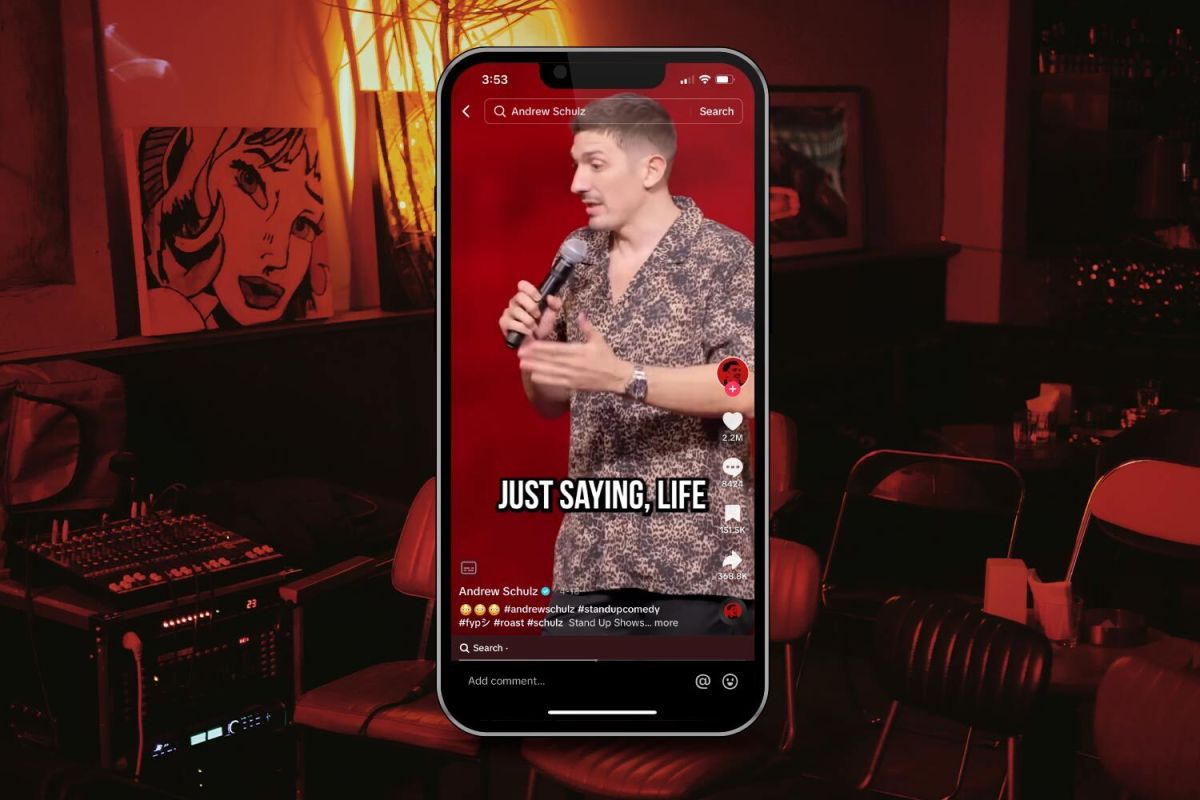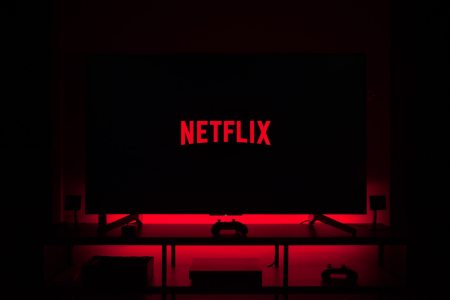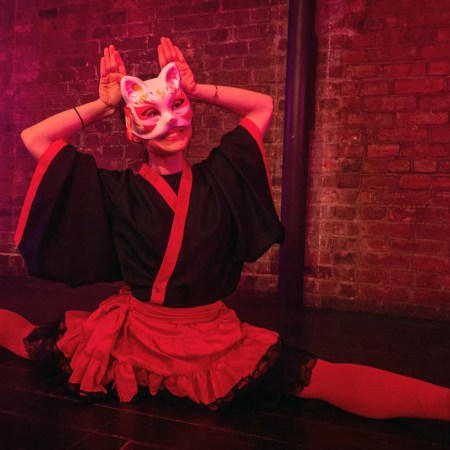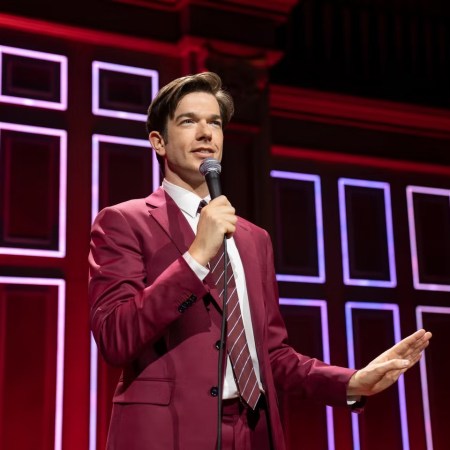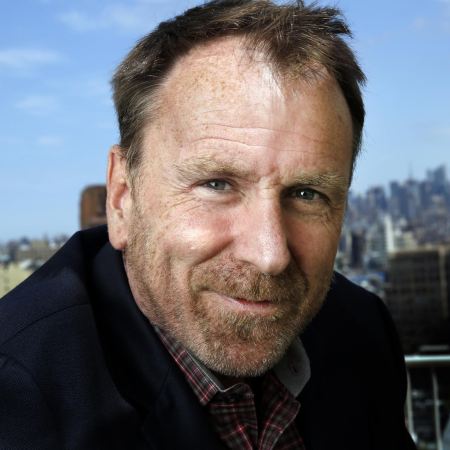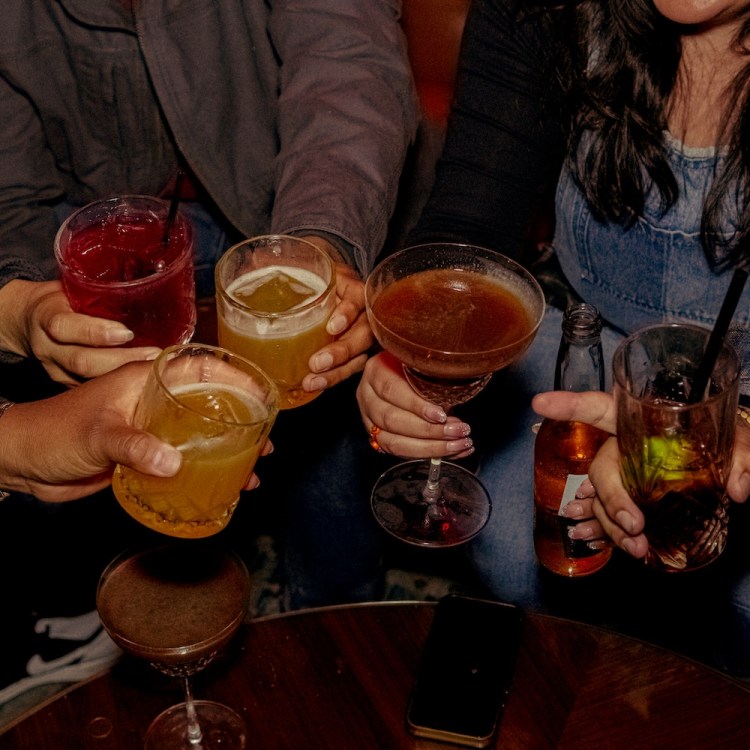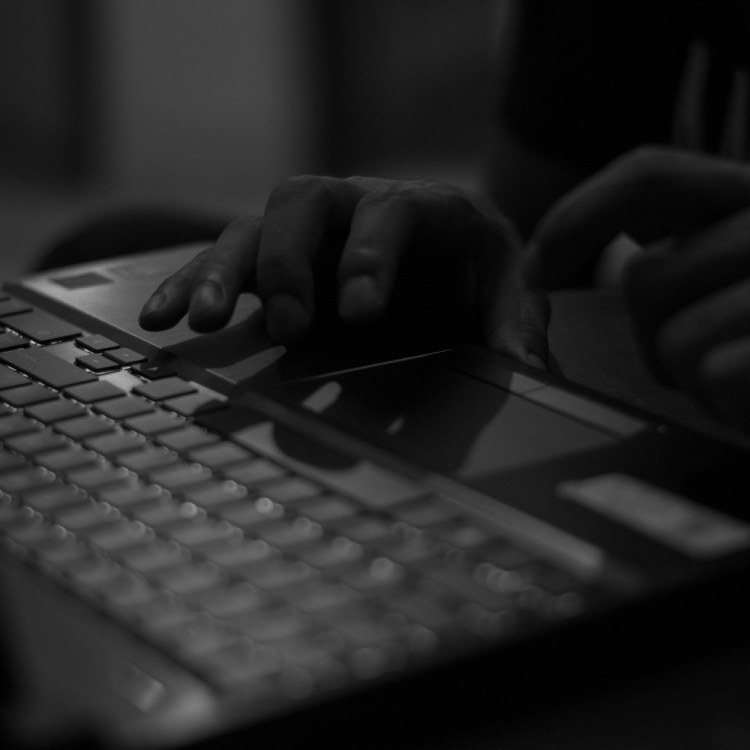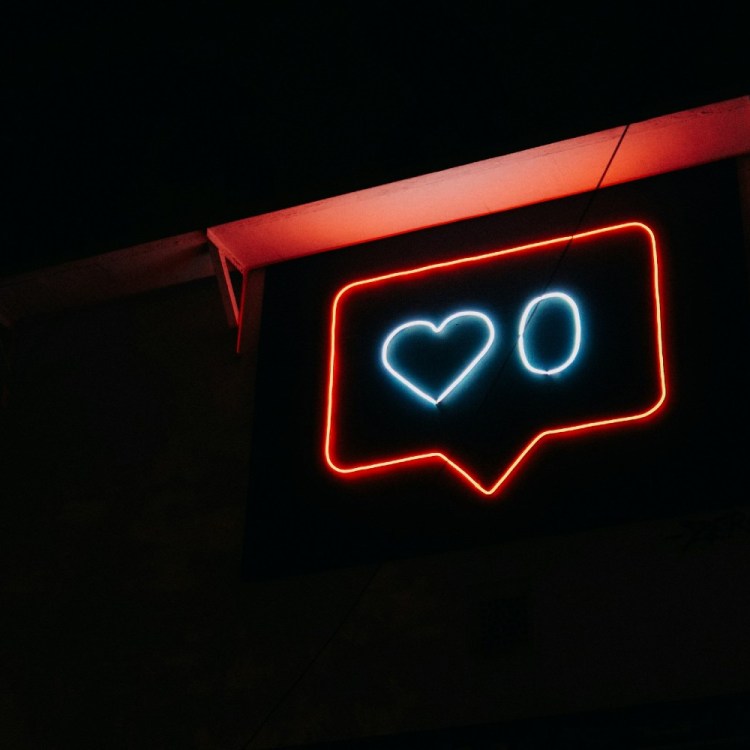Billy Procida, a comedian with 15 years in stand-up under his belt, recently delivered a set in the nude at a Brooklyn sex club. He was comfortable in that arrangement, though. On a twice-monthly basis he produces and hosts the “Naked Comedy Show,” so potential shrinkage wasn’t going to be the thing to throw off his timing. An audience member took care of that instead.
“I recently had an affair with a married woman,” one of Procida’s bits began, inspiring “woo”s and claps from the crowd. After tactfully waiting for them to calm down, Procida then revealed: “Also got into a fistfight with a married man.”
But the punchline’s expected laughs were quickly undone by a woman who inscrutably yelled “No!” at its conclusion.
“Whoa, OK,” a perplexed Procida said to her. Approximating that she was in her early 20s, he added: “This is not TikTok, I can hear you.” That line actually drew a bigger laugh than his rehearsed joke. He then said, to more chuckles, “I’m right here, there’s no screen.”
Moving on, he dove into another bit: “I slept with this woman recently; she’s an older — ”
“No!” the woman shouted again, this time mid-joke. In an Instagram video of the incident, Procida included a caption saying, “I was legit nervous I was about to yell at a disabled chick.” Over the crowd’s gasps of disbelief, Procida referenced a real trend among TikTok users who may or may not have Tourette Syndrome and said, “With the TikTok generation you’re all really into tics, so that’s now…” His anxiety caused a stumble, and he changed course. “I’ll stop because otherwise I’ll want to yell at you,” he said. Unable to contain himself, he then faced the audience for one last irresistible verbal smackdown: “With anyone under 25, I’m like, ‘Is this a disability or are you just annoying?’”
The audience applauded. They were on his side, appalled by the woman’s outbursts. However, as surprising as it might be to some that a crowd member would repeatedly interrupt a comedian — all of whom are extremely dependent upon plotted rhythms in joke execution — many stand-up performers are unhappily growing used to such behavior. Though it’s always been an issue, a number of comics say that heckling, an act that includes any verbal disruptions directed their way while onstage, is on the rise. The cause is precisely what Procida cited in his rant: social media, a powerful means of promotion for comedians that has upended their professional lives.
“I’ve heard a lot from comics that audiences are more vocal,” says Graham Kay, another veteran comedian, who hails from Ottawa, Canada, but has been based in Brooklyn for a number of years. “The things that get promoted on TikTok and Instagram are mostly crowd-work videos, so people see people talking to the comedian and it normalizes it.”
Sometimes, comedians engage in “crowd work,” initiating back-and-forths with audience members to create spontaneous humor and a deeper connection with them. But that’s generally not how stand-up shows work. The social contract accepted by most on either side of the mic stand is that the comic usually recites a string of words, which may have been toiled over for months in front of other crowds who did not react positively because the bit had yet to be honed. Then, eventually, the audience is compelled to laugh. However, as Kay and other performers say, social media, flush with clips of comics interacting with crowd members, of any age, appears to be changing audience expectations and eroding behavior standards.
“They probably have never been to a stand-up show, or they go once every five years, and so they don’t know the culture,” says Kay, referring to large swaths of comedy audiences. “So when they go for their annual stand-up show, now they’re talking more.”
Observing that he is “not famous” and performs in “a lot of crappy rooms” on the road where dealing with unruly crowds “has always been difficult,” Kay says he’s still noticed at least a modest, “five-percent” uptick in heckling. Other comics are complaining it’s greater than that, he says, but he notes that any increase in disruptions makes the job of the stand-up performer that much more difficult.
Of course, it’s the comedians themselves who are posting crowd work content to their social media accounts. But they’re left with little choice than to do so, forced to point guns at their own feet, thanks in large part to the rewards systems in place on the platforms. Per a number of digital marketing groups, social media algorithms favor users who post regularly. Doing so will probably lead to them procuring more likes, which prompts platforms to inject that content into feeds of the user’s followers, and even their non-followers. That exposure builds a snowball effect of more followers and even greater engagement, which for comedians may translate into ticket sales — the thing that actually puts money in their pockets. However, comedians only have so much material to “burn,” as they say. Developing just 10 new minutes’ worth of jokes that are sure to amuse a variety of audiences each year was a relatively high standard for comedians a few decades ago. Back then, brief, annual appearances on late-night TV shows was a primary goal. But, nowadays, many performers work on an hour of new material over the course of about a year or two. They hope to score a stand-up special and/or record an album for air on streaming TV platforms and satellite radio, two more potential revenue streams. Still, posting even 30-second clips of their tried-and-true jokes once or twice a day on social media, as recommended by marketers, is unsustainable for comedians over the long term. Furthermore, if comics post all of their bits online, there’s less motivation for followers to pay for tickets and see them perform in-person.
To strike that balance between posting “enough” on social media while not burning too much of their material, crowd work videos come in handy. Because the exchanges are off the cuff, crowd work clip production does not require the same time and resources as the posting of a refined, no-doubter joke, which partly explains the volume of crowd work on social media. Amusing interplay between comedians and audience members also tends not to last more than a handful of seconds. Short clips of crowd work, then, are more appealing to the average social media scroller looking for quick bursts of entertainment. (While on the toilet with your phone you probably don’t have time for a 16-minute story about a comic’s visit to the Anne Frank House, no matter how hilarious it may be.)
There are ways to mitigate the impact social media trends are having on comedy crowds. Katie Boyle, another New York-based performer, originally from Ireland, says a stand-up show’s host “sets the tone” for the evening and should delicately explain to audience members how to act. “They need to say, ‘I’m really happy to have you guys here,’” Boyle outlines. “‘Before we even start I want to let you know some rules, and that is: don’t talk loudly while the comedian’s onstage, don’t heckle them, and only talk if spoken to.’” Boyle, who’s MC’d shows herself many times, also suggests that hosts who do crowd work themselves wrap up their introductory sets with a few well-crafted, more conventional joke-jokes. “Once audiences get all the rules from the host, get an example of a set of jokes, then they’ll settle in and get it,” Boyle says. “And then the host is coming back and forth [on and off stage], so in between comedians they can just remind them if they get out of hand.” She says comedy club staffers may also quietly instruct people not to heckle performers, which helps shows operate more smoothly and emerge more enjoyable for everyone.
But there are a host of other issues comedians have with social media, particularly its influence on what performers say onstage.
Because algorithms favor short clips, Kay says many comedians write jokes with that in mind, and include a “controversial thesis statement” in the initial stage of the setup. “Comedians are starting to do comedy not for the live audience in front of them, but they’re structuring their stand-up for a robot,” he says. “The [live] audience is coming second to a digital audience.”
And with crowd work all the rage on social media, some comedians engage with audiences while actively mining for a moment of shock and awe, with potential for virality.
“It’s like anything else: in the wrong hands it can be faked, it can be manufactured,” says longtime stand-up performer Colin Quinn about crowd work. “When it’s really spontaneous, it’s fine, [but] sometimes with these comedians, I’m watching and I’m like, ‘Hey, this person wasn’t doing anything and you’re just fuckin’ bullying them, you’re just trying to get them to say something so you can abuse them.’ That’s the other big crowd work trick.”
The lines between castigation and lighthearted joshing can be blurry.
Nimesh Patel is one comic who embraces crowd work and often films post-set Q&A sessions with crowds, uploading videos from them to his social media channels. In one, there’s a joke from his set about taking an Uber from Kansas City to Omaha. He gets into a conversation with the driver about the perks of living in Kansas City, which apparently includes both “BBQ’s” and “BBW’s.” Later, during the Q&A, a woman in the audience asks him how much the Uber ride cost him. “I didn’t actually take an Uber, it’s just for the joke,” he tells her with a smile, adding later: “Come on lady, what the fuck?”
The crowd is clearly with Patel in the clip, though, laughing hysterically after growing to like and trust him throughout his performance. Some sarcasm directed at a show attendee appears to have been earned. When it isn’t, audiences may certainly rebuke comics who exhibit poor form and are plainly nasty to their paying customers. (Just ask Michael Richards.)
Patel has deliberately leveraged social media to build his fan base — a following strong enough to award him gigs at such hallowed halls as The Theater at Madison Square Garden. He began performing stand-up in 2009, but it was during the COVID-19 pandemic, when comedy clubs were shut down, that people started to really notice his talent. He says he rolled out old performance clips he had on YouTube starting around June 2020, but it was on TikTok, a platform that at that point had not yet been utilized by many comedians, where his work really took off.
“The first stand-up clip I put on there got like 800,000 views,” Patel says. “I was like, ‘What the fuck?’ I never had 800,000 views on anything ever before, or even if you were to sum up everything I’d ever [posted]. Then I started feeding that machine like every day with a clip or two, and by March of 2021 I had amassed like 80,000 followers.”
But he’s well aware of the unintended consequences of posting crowd work clips on social media.
“I’m sorry if I’ve participated in dumbing down audiences, sorry if I’ve participated in causing people to heckle and all that,” Patel says. I ask him what percentage of that apology is sarcastic and what percentage is authentic. “A hundred percent on both,” he replies.
Patel, too, has experienced heckling while in written-joke portions of his act. He says he addresses it by telling the crowd, “Some of you might be here because you think I’m going to talk to you the entire time. That’s not what the show is; I’m sorry I led you to believe that that’s what it is.” Patel adds that it is “a point of pride” that he can so mindfully deal with such disturbances and work his way back toward his rehearsed material pretty seamlessly.
There are plenty more social media success stories in addition to Patel’s, illustrating the buoy its platforms have been to the stand-up industry’s frontline workers, in spite of its unintended consequences.
In December 2022, Eagle Witt posted a nine-minute bit to YouTube about the internal conflict he experiences as a half-Jewish, half-Black man who is also a fan of Kanye West’s music. Witt felt compelled to make the presentation public during a period of backlash against West, after the rap artist and fashion mogul made a string of anti-Semitic remarks. “I’m a Kanye fan and it is hard work,” Witt says in the routine. “It’s like being a lawyer with no evidence. Every day he be sayin’ the wildest shit imaginable, and I be like, ‘Yo, but the beats though!’” However, in Witt’s mind putting the video up on social media was a risk. He’d only been working on the bit’s core material for a month and wasn’t sure it was yet strong enough for publication. It was also his first YouTube post, so his following on the platform was zero.
But the gamble paid off. The clip attracted tens of thousands of views, and soon Comedy Central had recorded Witt performing the material again. Comedy Central was already planning on filming a set of his, according to Witt, but after he dropped the Kanye West bit on YouTube, a company representative specially requested he perform it during the taping. Comedy Central posted its new version of the routine, with heightened production value, on its YouTube channel in March 2023. Views of that video are approaching 650,000, boosting Witt’s profile in the process.
“I’ll have people walk up to me on the street and say, ‘Yo, I love that Kanye set,’ and they don’t even follow me,” says Witt, who admits that when it comes to social media posting, personally, he’s a “quality over quantity guy.” While he doesn’t post regularly, he concedes that social media marketing “definitely helps fill seats,” and in his experience, the level of heckling that’s come with online crowd work videos has been “a little catastrophized by comedians.”
“I don’t think it’s as bad as everybody says; I think it’s very light,” Witt says. “It’s very easy to shut down and it’s not every show.”
Like Nimesh Patel, Sam Morril also capitalized on the democratization of content publishing, via social media, during the early days of COVID. Because clubs had been abandoned, “YouTube was really an act of desperation,” says Morril. “It was like, ‘I want people to see the work that I worked hard on.’ I’d been touring hard on an hour; you put a lot into that. If you’re a real comic who does the road, you are honing it in a bunch of different cities, and you’re sick all the time, [and] you’re like, ‘How do I fucking nail this?’”
His solution during a viral pandemic? Invade rooftops with audiences and a small film crew.
“I was one of the earlier comics to just put a special on YouTube, and I would definitely say I was one of the early ones to do it who had done TV specials already,” Morril says. “I didn’t ever do this with the expectations of getting on Netflix. The expectation was: hopefully people buy my tickets to see me on the road.”
When I ask him if he saw an uptick in ticket sales after his early-pandemic YouTube posts — the primary one has achieved 2.2 million views — he says, “Absolutely.” He just wrapped a tour in countries abroad and is now presenting a new hour in clubs across the U.S.
Less than four years after his rooftop shows, however, Morril observes that now there are so many comics promoting self-produced YouTube specials that catching a break on the platform might be too difficult for them.
Along with other comics I’ve interviewed, he also says that Instagram is penalizing users who post edgy jokes about sensitive topics by pushing them further down in people’s feeds. This has led to comedians bleeping out or dropping curse words from the audio of their posts and censoring their own captions.
“That could influence maybe the way a comedian writes because they want their jokes to be seen,” Morril says. “It’s very tricky because we’ve been blessed to be able to circumvent this industry, but at the same time, now these companies like Instagram, all they care about is ad sales, and they have an easier time making money if they have clean comedy clips.”
He says he remembers a time not too long ago when “a lot of comics would break on Instagram with the most provocative shit ever.” That time may have already passed.
This new algorithm may be perfect for a comedian like Tony Deyo, who might strategically inject a curse word into his set here or there, but generally works clean. Much of his material focuses on family life, and it was one bit about fatherhood that made him an accidental viral sensation.
“Whoever invented the phrase, ‘Slept like a baby,’ they didn’t have a baby,” goes the setup from a joke Deyo performed and then posted to Instagram in the fall of 2022. “I don’t think they’d ever even seen a baby. I think that phrase should be, ‘Slept like an adult … that doesn’t have a baby.’” The video has nearly 125,000 likes on Instagram, but it was the moms on the platform whom Deyo credits for a big boost to his following. Swarms of them lip-synced and acted out his bit while cradling their own kids, hashtagging their videos with phrases like “#sleepdeprived.” They put their own creative spins on the presentation, and dads got in on the trend as well. Its virality infected TikTok, too.
Deyo’s had a couple videos catch fire on social media, likely due in part to the effort he puts into their production. He uses Final Cut Pro editing software and says he is “very particular about audio.” Says Deyo: “I spend probably a lot more time on these than other people do. It’s a perfectionist’s mentality.”
The result has been a much more robust following on social media, and when he’s on the road people will tell him they’ve seen the viral clips. (He also says he’s learned of joke thieves who’ve lifted his material from the internet and incorporated it into their own sets.) But in his mind, the 20-year veteran comic says the return on investment has been questionable.
“I would still prefer not to have to do this, even though it has helped me out,” Deyo says of social media marketing. “I sort of wonder: the amount of effort I’ve put into it over the last year and a half, it didn’t translate into that much extra [revenue]. I still feel that I would rather just write jokes and tell jokes, and that’s all I really want to do, and everything else kind of is just getting in the way of me doing that at a higher level.”
Even comedians like Sam Morril, who can afford digital marketing teams that post on their behalf, are annoyed by the responsibility of regularly issuing content.
“It’s hard enough for me to even find the time to approve clips, I’m so fucking busy,” he says. “I don’t have time to do shit.”
Tom Ryan, a comedian who quit his day job in June 1988 and has maintained a full-time career as a stand-up ever since, says he’s contemplating posting videos to social media on a regular basis for the first time. “That’s the new game,” he says. “The key is, throw the content out there; you never know what’s going to connect.” He has accounts on all the major platforms except TikTok, but that might change soon, along with his approach to performing. Observing the trend of crowd work videos on social media, he says it’s a skill he hasn’t used in many years, but looks forward to redeveloping it. Ryan also bought a MacBook because other comics have told him the video editing software on them is more user-friendly than on other devices.
He knows he has to try something. Referring to his 35-year run as a professional comic with no other means of income, Ryan says, “My streak might be over this year.” He says he’s struggling to book stage performances, so he’s cat-sitting to make extra money. “You never know,” Ryan says, “I’ve been in a jam before and something always comes through, [but] so far it really hasn’t.”
Netflix Just Live-Streamed a Comedy Show. Will Sports Finally Be Next?
The TV innovator has yet to stream live sports, even while its biggest competitors dive into the category. But there might be good reasons to not go there.Ten-year veteran comic Max Fine has historically posted infrequently to social media, but the recent release of a full-length comedy album has provided him the opportunity to issue material on Instagram in cut-up clips. “Recording all of that material meant that I wasn’t going to be able to use it again onstage,” says Fine. Given the nature of joke-telling, with some unpredictable, incongruent twist turning up in the punchline, any prior audience familiarity with the material renders it far less effective. “My whole hesitation with posting something has always been: if I post a joke and then two months later I find a way to make it another minute longer with more tags to it, I don’t want that original joke being [public] because it’s already gonna spoil whatever’s coming next with it” to new audiences, explains Fine.
The thought of slowly distributing such work to the masses for free may have been unthinkable to comedians of yesteryear, though. Performers with a new album like Fine would have rather just straight-up sold records. But he hopes that posting portions of the album to Instagram might encourage followers to seek out his album on Spotify, which will funnel some monetary returns back to him, similarly to how performers earned album royalties from sales back in the day. However, more in the forefront of his mind is the chance to finally “feed the algorithm,” he says, with jokes he’s now retiring because of their presence on his album.
There are those willing to use social media as an outlet to fulfill creative juices that take them away from stand-up comedy, too. In addition to posting clips from their podcasts — something seemingly every comedian has — comics also venture into sketch comedy on social media.
Stand-up performer Katie Hannigan films her own skits, co-written and co-starring her boyfriend, fellow comedian Mike Vecchione, and posts them on Instagram. In the videos they satirize contemporary coupledom, and Hannigan says she sees this effort as a chance to show off her writing and acting chops, potentially to industry folk. “Part of being an artist is existing in this space where you’re like, ‘I’m really excited, I think we’ve got something really fun, this could take off and if it doesn’t, it’s another cool thing that I’ve done that’s in my portfolio,’” she says. She adds that people have attended her shows and told her they love the sketches with Vecchione.
A number of comics post videos in which they respond to news stories and other internet content, while Akeem Woods takes to social media to tell amusing and racy personal stories from his love life. He frames the clips essentially as a web series that he calls “Trollop Tales.” There’s one about the time he had sex in a Chick-fil-A parking lot, another about an “accidental threesome,” and one where he hooks up with two “straight guys” — quote marks are his.
“Comedy has changed so drastically,” says Woods, who admits to paying an editor to take some of the digital marketing weight off his shoulders. “I don’t know if it’s for the good or for the bad; I guess there’s pros and cons to it, but now we have to be on social media and we have to excel at it, so I’m trying to be better at it.”
Graham Kay mourns the loss of industry “gatekeepers” who were excellent judges of talent and helped propel the best comics forward. In today’s stand-up world, “Nobody cares if you’re good at live stand-up,” says Kay. “The only way we can break out is by getting noticed on social media … What that means, though, is that there’s also no more quality control as to what gets big.”
With that perceived lack of structure in place, an individual’s entire approach to cultivating a stand-up comedy career from scratch has also been disrupted by social media.
Pinky Patel (no relation to Nimesh) is a performer of stand-up comedy with a tour booked through March 2024 spanning the U.S. and Canada. Her five million-strong TikTok following has helped her sell out theaters — and sell products on behalf of brands. But just a few years ago, before COVID-19, the 43-year-old from Chicago says she was “kind of an ordinary mom” with “a corporate job.” Like many others, during the pandemic she became a superstar content creator. Growing upset with the continuing crisis in 2020, she decided to express her frustrations with what was going on in the world and its impact on her family online.
“I started taking the random thought of the day and saying it [on social media], which was really new for me because I was never in front of the camera,” Patel says. “I used to hate having my picture taken and I didn’t want to be the center of attention, I didn’t want any of that stuff.”
Serious content grew into “goofy” content, where, among other approaches, Patel would imitate her mother and amusingly describe the Indian immigrant family experience from a first-person perspective. Before she knew it, a couple of her videos blew up. Her following grew and in the summer of 2021, Stefani Schweda Jerard, the manager of popular stand-up club the Chicago Improv, reached out to Patel.
“She’s like, ‘Hey, I think your TikToks would resonate well as stand-up comedy because you’re seeing something, you’re making an observation and you’re making fun of it, and people are laughing and having a good time,’” Patel recalls. “I was like, ‘Really? I thought I was just being an asshole.’”
Thinking she was booked to perform five minutes on stage, she eventually learned she’d been tapped to headline a show and present 45 minutes of material — news that only exacerbated her stage fright. But in a week she wrote enough to fill the time, simply drawing from personal experiences. The show sold out and her performance was good enough for her to get another gig, then another and another. With the help of Schweda Jerard, the shows grew bigger and were booked further away from Patel’s home city. She developed a new set focused on what she’s learned about social media and life by becoming a viral star. Her current performance, which spans 75 minutes, is about how her family has dealt with her career change and fame.
In the minds of many comics, the kind of pathway toward stand-up stardom that Patel took is riddled with shortcuts and not worthy of respect. Famous TikTokers and YouTubers didn’t pay their dues, they might say, which include countless unpaid performances in the wee hours of weeknights to work out an act onstage in front of sparse audiences made up of drunk and sleeping patrons. (And that’s one of the most fun parts of becoming a comedian.)
“Since the pandemic, when I’ve been on the road and either done the big clubs or hung out at the big clubs, there have been times where the headliner has been somebody that I didn’t know, which has never happened in my 20 years of doing comedy,” says Trey Galyon. “You’ve never heard of them before and it’s because they came from the YouTube world or the TikTok world.”
Galyon says such performers tend to draw “a lot of young kids” at shows, and onstage they tell stories as though “they’re that person at the party that wants attention.” Galyon adds: “And that’s pretty much what their act — if you want to call it an ‘act’ — is.”
Nimesh Patel says he’s heard of TikTok and YouTube stars who, on stand-up comedy stages, exhibit PowerPoint presentations breaking down the viral videos they posted to social media. “The staff will be like, ‘That motherfucker is not a comedian, [but] he just sold 300 tickets,’” Patel says. “That’s not comedy, but if that’s what fans want, that’s what fans want.”
Where this phenomenon becomes problematic for comedians is it means fewer shows on which they can feature. And while the pandemic helped rocket those non-traditional performers to fame and financial security, it also sealed the fates of many stand-up clubs across the country that could not survive without fans flocking to their rooms. Conflating the reality that more gigs go to people with sizable social media followings — and acts of questionable merit — with the fact that there are fewer stages to begin with means more comedians are finding it tougher to make ends meet.
Zoe Friedman, co-founder of Comedy Gives Back, a charitable organization providing various resources to comedians in need, including financial relief, says COVID club closures have led to an increased number of requests for support from her group. She says it’s difficult to measure any potential economic impact that the rise of social media stars has had on established comedians; however, she says it is “possible” that their claiming of stand-up club spots has been detrimental to the career sustainability of longtime working comics. “It is something that people are talking about, yes,” Friedman says. “I don’t think that in their application it’s going to say [that] directly. It’s more: ‘Spots have dried up.’” While a general description like that could indicate that some pleas for help to Comedy Gives Back are the result of social media stars absorbing stand-up club performance slots, it can also highlight other troubling developments. Friedman says cruise lines, which suffered during the pandemic along with comedy clubs, are offering fewer show opportunities of late. In other cases “spots have dried up” might reflect the plight of older comics who’ve just aged out of the scene.
Pinky Patel has heard the grumbles from comedians about TikTok and YouTube stars “taking” spots away from established stand-ups. But while she’s traveled a non-traditional course to theater stages as a performer of comedy — “luck has been on my side,” she says — her efforts to build a reputation as a reliable entertainer in the medium have been profound and authentic. Why? She’s always loved and admired stand-up comedians, and does not want to dilute the industry or hurt its reputation with performances of poor quality.
Patel can’t say the same for one stand-up comedian, who she didn’t want to name, and who had gained a following primarily by posting crowd work clips to social media. “From what I’ve seen on social media, to what I saw on stage, I was underwhelmed,” she says. “I was not as happy as I am with their social media content.”
Schweda Jerard has watched Patel’s transformation — and the work that’s gone into it — from a front row seat. She says Patel is “one of the few people that I’ve seen come from a social media sensation to the stage of comedy and been able to develop the craft.” She adds: “A lot of times you have all these people and they’re on social media, and they have all these followers, and just because they have followers, they think they can do stand-up. That’s not the case at all.”
Patel believes anti-TikTok-star sentiment in the stand-up community led to another female comic “shitting” on her for being from the social media influencer world while onstage performing at a show in which Patel was the headliner. But it was Patel herself who helped choose the opening act. When asked by promoters who she’d like to see support her on a bill, she says she always suggests women and members of the LGBTQ+ community because they get fewer opportunities for stage time compared to cis males. However, it was the last time that performer will appear on any lineup headlined by Patel.
From a strictly business perspective, it makes sense for comedy clubs to book social media stars, even if they don’t perform anything that looks like stand-up, because of their built-in audiences.
“If you sell tickets, I don’t care how you sell them,” says Brian Heffron, founder and CEO of the Comedy Zone chain of stand-up clubs. “YouTubers are coming through my system on a regular basis … I’m seeing a lot of really happy customers, and I’m seeing a lot of really good talent.” He says the same percentage of social media stars who bomb on stages is about the same percentage of stand-up comics who commit the same offense.
Comedian Dusty Slay, who has also leveraged social media to build a bigger following by posting jokes, but also podcast clips and a series of travel videos, says the comedy club infiltration of TikTokers and YouTubers has not had an adverse affect on his ability to land gigs. He says such non-traditional performers may not present “stand-up,” but do oftentimes deliver “comedy.” If they’re helping comedy clubs keep the lights on by bringing social media scrollers into seats, he supports their presence in the community — with one caveat.
He’d prefer to see social media stars with undeveloped acts get their shot at stage time on nights of the week, such as Monday and Tuesday evenings, where comedy clubs may otherwise struggle to attract crowds. “If they’re taking weekend spots, that’s a little different,” says Slay. “A lot of times, a comic who is not really selling a lot of tickets, but is very good and is building up [a following] will need Friday and Saturday nights because that’s when people will come out just to see comedy. They’ll say, ‘Oh, we’ve got the night off, let’s take a chance on this [performer].’”
Shawn Eckert, general manager of Helium Comedy Buffalo, a stand-up performance space that’s part of a chain of clubs, says he’s seen social media stars seek counsel from established comedians so that they may improve their sets. He says booking TikTokers and YouTubers, as well as stand-up comedians who’ve grown their following through crowd work videos, is “a crapshoot.” Their previous efforts in entertainment might not exactly translate on stand-up stages in front of paying audience members. When that happens and customers complain to a club manager, Eckert says they might apologize, but, generally, customers won’t hold a single bad show against a venue. However, Eckert also says there have been instances where social media stars getting started on the stand-up circuit were booked for a single weeknight with modest returns — in terms of ticket sales and show quality — but within a year were selling out entire weekends’ worth of performances. They got strong laughs, too.
“We have a good finger on the pulse as far as who’s putting in the work,” Eckert says. “We have the luxury of having seven clubs across the United States, so we can work them in all rooms and kind of gauge how they’re doing — a bigger market [versus] a smaller market.”
And club owners and managers of even competing spaces openly discuss the quality of acts they book. Giving a couple examples, Eckert says he’s in constant contact with leadership at the Pittsburgh Improv and another club in Toronto because comedians hit those stages on their way to and from Buffalo. They trade information on what to expect from a comedian in terms of act and turnout. “So we usually have a good bearing of what’s coming up,” says Eckert.
Booking a TikTok or YouTube star, thus, Eckert says, has never been a “total waste.” And as far as Heffron is concerned, if a comedian is struggling on the road, it doesn’t serve them to blame performers who originated in the social media world. They should instead take that energy and put it toward improving their stage act.
“YouTubers aren’t keeping you from working in the comedy business,” says Heffron. “Stand-up comedy is not a team sport, so why are you worried about what other people are doing? It has no bearing on your life, you’re not losing work to anyone because you’re not being undeniable to me and my agents and my peers. If you’re undeniable onstage I don’t give a shit how many YouTubers are out there, we want you, we need you.”
If anything, Heffron thinks more comedians should willingly incorporate social media responsibilities in their day-to-day, instead of bemoaning the platforms’ existence. (A number of traditional, experienced stand-up performers who did not get their start on YouTube or TikTok already market themselves as “social media sensations.”)
“YouTube and Tiktok and whatnot are just more tools,” he says. “They don’t affect how funny you are or what your staying power is or your ability to write and develop your act and your point of view and all that.”
There’s a monthly show at an event space in Astoria, Queens, called Q.E.D. that features an entire bill of up-and-coming comics who view social media in just such a light. Produced by comedian Pete Bladel, “You Should Post That” is restricted — with some very rare exceptions — to stand-ups with fewer than 10,000 social media followers. They get on the show to present a killer set, like always, but with an added bonus: Bladel supplies them with a high-quality digital video of their performance, with excellent audio tracks as well, so that they may post clips from it to their social media channels. He says sometimes the show’s videographer, Drew Jordan, will cut up the 15-minute video into clips for the comics as well, making it even easier for them to post the content.
“I just wanted to do something nice for other comedians, especially comedians who maybe get overlooked or don’t get as many opportunities,” Bladel says of his motivation behind starting “You Should Post That.” Of social media in comedy, Bladel says it has “democratized things a little bit, but not without its drawbacks.”
Plenty of comics are taking the good with the bad that comes with the new responsibility of social media marketing.
“It’s not like it used to be easy and now it’s hard,” says Graham Kay, the one-time Ottawan turned Brooklynite. He says being a social media guru is just “another hard thing” in a string of challenges comedians seem to encounter on their professional journey constantly. Kay also says he doesn’t want to “come across as bitter” when he speaks about the impact social media has had on the job of the stand-up comedian and their audiences.
“I’ll figure it out, I’m doing it, grinding along, making a living doing what I love,” says Kay. “I still love it, it’s still super fun. There’s still plenty of great crowds, it’s still really fun to go to a hot club on the weekend and you can still just crush.”
This article appeared in an InsideHook newsletter. Sign up for free to get more on travel, wellness, style, drinking, and culture.
